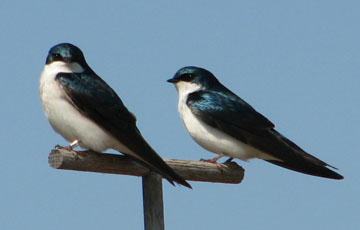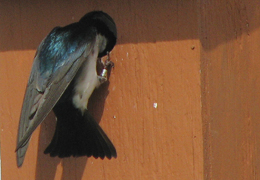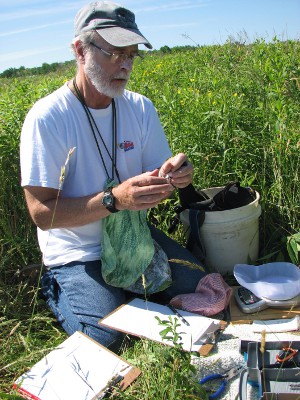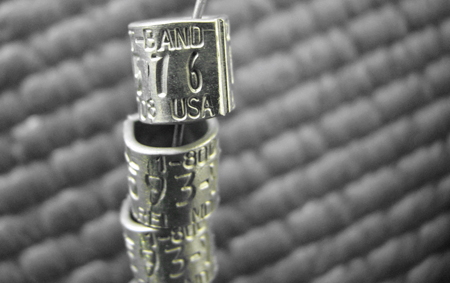Should you consider banding your Tree Swallows?
Bird banding is a special way you can learn about songbirds in general and your adult and nestling Tree Swallows in particular. A banded bird carries a uniquely numbered light-weight aluminum band that identifies it for the rest of its life and that can also identify its body after death. You should consider having your swallows banded, especially if you plan to operate your project for several years, as we hope you do.

Why Band Birds?
According to the North American Banding Council recapturing live banded birds and recovering dead banded birds yields data that is valuable in the following ways:
- By tracing movements of birds we learn their migration routes, range expansions and contractions, and dispersal of age classes.
- Banding also lets us measure demographics and dynamics of different bird populations, and reveals survival rates of age groups and age profiles of populations.
- Banding helps ornithologists studying territory sizes, dominance hierarchies, habitat selection, changes in plumage and weight during the passage of time.
- Environmental scientists use banding in order to better understand effect of contaminants, incidence and spread of infectious diseases, and responses of birds to experimental research variables.
- Conservation departments use banding data so that they can set game-bird hunting seasons and harvest limits.
- Scientists often utilize banding to monitor population levels and trends of threatened or endangered species.
For more information on the value of banding visit these web sites: the US Geological Survey’s Bird Banding Laboratory and the Dept. of Environment and Climate Change Canada’s Bird Banding webpage.
The Golondrinas Handbook has specific procedures recommended for trapping, handling, and banding Tree Swallows.
Below: a string of one hundred of the size 1 bands used for Tree Swallows.

Here’s what can you learn by banding your Tree Swallows:
If you’ve established a good Tree Swallow nest box project you can generally expect 30%-60% of your adult breeding swallows to return from year to year. So, through banding and recapture over several seasons you can learn a lot about your adult birds as individuals and about your breeding population as a whole.
Therefore, although nestlings typically return at much lower rates there is still value in banding them.
For example, here’s a sample of some things systematic banding of your Tree Swallows can teach:
- How many adults return each year, and what their annual return rates are.
- What the minimal annual survival rate of your population is.
- The age class composition of your population.
- Which sex is more apt to return, males or females.
- If return rates vary with nesting success or failure the previous year.
- If returning pairs keep the same mates or nest with new partners.
- How frequently returning birds use the same box.
- Which sex moves farther from their old box, if they do move.
- If females lay the same number of eggs each year, or whether it changes as they age.
- If wing length changes from year to year.
- Whether number of young raised changes as females grow older.
- If birds banded at your project are recovered or recaptured elsewhere.
- How often birds banded elsewhere come to your project to nest.
- If nestlings raised at your project return as adults to nest.
- How nestling return rates compare to those of adults.
That’s a lot of stuff, important insightful stuff, so having your birds banded might really be worth it!

Finding a bander for your Tree Swallow project:
- Please realize that governments of Canada and the US bird regulate banding strictly. Persons must pass bander training courses and possess government permits in order to band.
- Unless you have these qualifications you’ll need to locate a licensed bander for help.
- Local bird clubs or your state or province’s conservation department can assist your search.
- You could also contact one of the National and Regional Banding Associations in order to find names of banders in your area.

What if you aren’t having your swallows banded, but know one of your nesting birds already has a band?
- You can try trapping it yourself. (See Banding Adult Tree Swallows).
- If you capture the bird note the band number. You may need a magnifying glass.

- Try to determine the swallow’s age and sex (See Sexing and Aging Tree Swallows).
- Report band numbers online to the USGS Bird Banding Lab or Natural Resources Canada.
For additional information see Banding Adult Tree Swallows and Banding Nestling Tree Swallows.
—————————————————————————————–
Home: Tree Swallow Nest Box Projects
Creating Tree Swallow Nest Box Projects
Spring Return
Nesting Season Behavior
Song and Calls
Nest Site Claiming
Pair Formation
Nest Building
Bird Flight
Mating and Paternity
Diary of One Season at Salmon Creek
Monitoring Nest Boxes and Keeping Records
Making Box Checks Keeping Box Records Control Sheets Season Summaries Print Sheets
Banding Your Tree Swallows Banding Adults Banding Nestlings
Tree Swallows in Research Research Bibliography Glossary of Terms